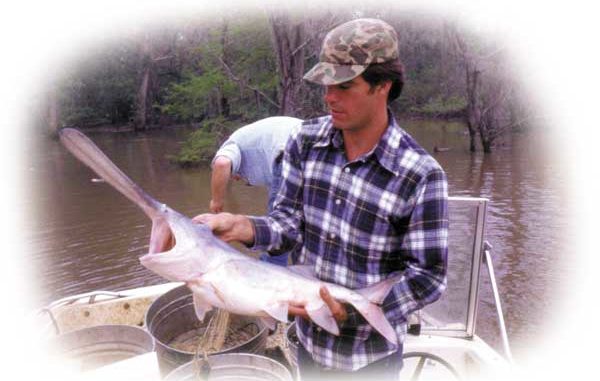
Follow the advice of the state’s former deer study leader, and you’ll make your small property the one place every buck wants to come to.
Paddlefish, or spoonbill catfish as they are often called by freshwater fishermen, are a primitive fish species found in almost all of Louisiana’s natural water bodies. They are often seen by commercial fishermen, but few sportsmen notice them because they do not bite on hooks. They feed by straining microscopic animals (zooplankton) from the water with their huge mouths.These fish were once very common in much of the United States. By the early 1900s, their numbers were much reduced, probably due to habitat destruction, pollution and/or overfishing.
During the first 20 years of the 20th century, some paddlefish were harvested for their roe (eggs), which was used to make a caviar product. Prices were $1.50-$2.00 per pound for the eggs, a huge amount back then.
Louisiana was the first state in the U.S. to protect paddlefish when the state legislature approved a closed season in 1914. This was later changed, and protection was provided with a 15-pound minimum-size limit.
Later, commercial paddlefish harvests were low, averaging less than 27,000 pounds per year between 1966 and 1986. All the harvest during this period was for their flesh rather than their roe. Prices were also low, ranging from 11 to 37 cents per pound.
Then in the late 1970s, the U.S. banned all imports from Iraq and Iran, two of the world’s largest sturgeon caviar exporters. U.S. markets turned again to paddlefish roe as the next best substitute, and prices for the roe rose to $12 to $15 per pound.
Nonresident commercial fishermen began fishing for paddlefish in Louisiana around 1984, concentrating their effort in the Mermentau River. Because of public concern and the fact that so little was known about the health of the fish’s population, the fishery was closed by the Louisiana Wildlife and Fisheries Commission in 1986.
Commercial harvest is still prohibited, but recreational anglers are now allowed to take two fish per person per day, except in saltwater areas and border waters shared with Texas. Also, paddlefish with a lower jaw fork length of more than 30 inches must be released. Lower jaw fork length is measured from the front tip of the lower jaw to the fork in the tail fin. Possession on the water of paddlefish eggs removed from the fish is also illegal.
After 1986, Louisiana Department of Wildlife and Fisheries biologists began conducting substantial research on the fish, sampling their population and tagging and releasing both wild and hatchery-raised fish. Biologists used gill nets, otter trawls and hook and line snagging to sample the Calcasieu, Mermentau, Atchafalaya and Pearl rivers, two backwater swamps, Henderson Lake and Larto-Saline, and three lakes, Yucatan, Grand (in Southwest Louisiana) and Pontchartrain.
During a three-year period, 334 paddlefish were collected. All fish were measured, weighed, sexed and aged by counting the rings in a cross section of their jawbones.
Highest catch rates were in Lake Henderson, followed by Lake Pontchartrain. No paddlefish were caught in Calcasieu River or Yucatan Lake.
The smallest fish caught was 24 inches long and the longest, a male fish, was 63 inches. The heaviest was a 46-pound female. Although other studies indicate paddlefish can live to 30 years, no fish older than 14 years were captured in Louisiana.
Male paddlefish began maturing by 4 years of age, and by age 9, all were mature. Females began maturing at 7, and all were mature by 10.
Spawning takes place in the spring, as the fish begin to migrate up rivers when water temperatures are between 50 and 66 degrees. Males seem to spawn every year and females once every 2 to 5 years. The largest number of mature fish was found in Lake Pontchartrain.
Females captured in the study had egg-count estimates of 65,716 to 136,843 per female.
Paddlefish can make long migrations. In Louisiana, paddlefish have been observed to travel 40 miles from Toledo Bend Reservoir into Texas through the Intracoastal Waterway. Movements of 500 to 800 miles have been observed in the Missouri River.
Catching a paddlefish is not an everyday event for recreational anglers. In spite of having outlandishly large mouths they feed on very tiny foods, too small to put on a hook.
Most often, they are caught by being accidentally hooked in the mouth as they swim open-mouthed while straining plankton from the water into a hook baited for other species. This occurs more frequently on trotlines, but occasionally one is hooked with a rod-and-reel.
It is common for boaters to hit and injure paddlefish swimming near the surface with the lower unit or propeller of their outboard motor. Paddlefish are famous jumpers and will, for no apparent reason, launch themselves from the water and high into the air, like a silver Polaris missile. While jumping doesn’t seem to be a group activity, when one fish jumps, other fish in the area can often be seen leaping.
Paddlefish can make good table fare if properly prepared. Like many primitive fish, it has very long muscle fibers, making the meat in a fillet seem fibrous. Steaking them, cutting across the muscle grain, solves this problem. They may then be prepared like any other mild-tasting, white-fleshed fish.
Jerald Horst is an author of the Angler’s Guide to Fishes of the Gulf of Mexico, a 444-page, color-illustrated book on fishes written for saltwater fishermen. The book is available in better bookstores or can be ordered by calling 800-843-1724.


